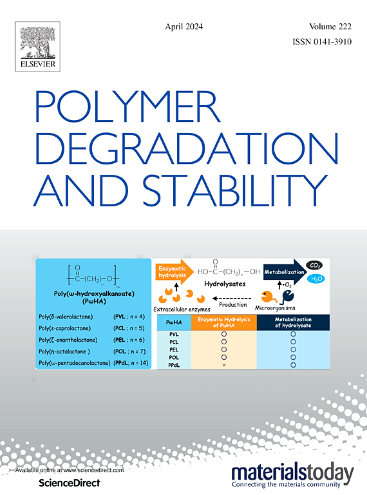Thermal oxidative aging behavior and lifetime prediction of fluoroether rubber
IF 7.4
2区 化学
Q1 POLYMER SCIENCE
引用次数: 0
Abstract
Fluoroether rubber's performance offers extensive application potential in harsh conditions. This article investigates the thermal-oxidative aging behavior and life prediction of fluoroether rubber using methods such as Fourier Transform Infrared Spectroscopy (FTIR), Thermal Gravimetric Analyzer (TGA), Differential Scanning Calorimeter (DSC) and Compression Set. Results indicate that with prolonged aging, fluoroether rubber exhibits decreased heat resistance, damaged TAIC crosslink structures, and weakened characteristic peak intensities of main chains and side groups, leading to changes in rubber structure. Throughout the aging process, hardness, physical crosslink density, glass transition temperature, and compressive stress gradually increase, while mechanical properties decline. Using compression set as an indicator, service life at various temperatures was predicted, providing theoretical guidance for improving the reliability of fluoroether rubber seals and expanding their engineering applications.

氟醚橡胶的热氧化老化行为及寿命预测
氟醚橡胶的性能在恶劣条件下具有广泛的应用潜力。采用傅里叶红外光谱(FTIR)、热重分析仪(TGA)、差示扫描量热仪(DSC)和压缩集仪(Compression Set)等方法研究了氟醚橡胶的热氧化老化行为和寿命预测。结果表明,随着老化时间的延长,氟醚橡胶的耐热性降低,TAIC交联结构受损,主链和侧基特征峰强度减弱,导致橡胶结构发生变化。在整个时效过程中,硬度、物理交联密度、玻璃化转变温度和压应力逐渐升高,而力学性能下降。以压缩集为指标,预测了氟醚橡胶密封件在不同温度下的使用寿命,为提高氟醚橡胶密封件的可靠性和扩大氟醚橡胶密封件的工程应用提供了理论指导。
本文章由计算机程序翻译,如有差异,请以英文原文为准。
求助全文
约1分钟内获得全文
求助全文
来源期刊

Polymer Degradation and Stability
化学-高分子科学
CiteScore
10.10
自引率
10.20%
发文量
325
审稿时长
23 days
期刊介绍:
Polymer Degradation and Stability deals with the degradation reactions and their control which are a major preoccupation of practitioners of the many and diverse aspects of modern polymer technology.
Deteriorative reactions occur during processing, when polymers are subjected to heat, oxygen and mechanical stress, and during the useful life of the materials when oxygen and sunlight are the most important degradative agencies. In more specialised applications, degradation may be induced by high energy radiation, ozone, atmospheric pollutants, mechanical stress, biological action, hydrolysis and many other influences. The mechanisms of these reactions and stabilisation processes must be understood if the technology and application of polymers are to continue to advance. The reporting of investigations of this kind is therefore a major function of this journal.
However there are also new developments in polymer technology in which degradation processes find positive applications. For example, photodegradable plastics are now available, the recycling of polymeric products will become increasingly important, degradation and combustion studies are involved in the definition of the fire hazards which are associated with polymeric materials and the microelectronics industry is vitally dependent upon polymer degradation in the manufacture of its circuitry. Polymer properties may also be improved by processes like curing and grafting, the chemistry of which can be closely related to that which causes physical deterioration in other circumstances.
 求助内容:
求助内容: 应助结果提醒方式:
应助结果提醒方式:


